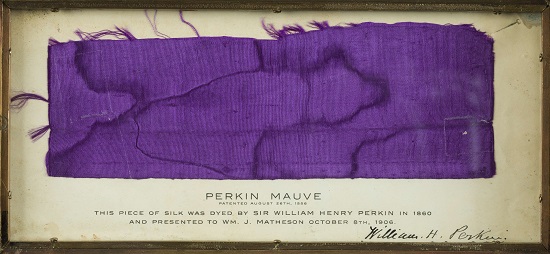Have you ever wondered what color "mauve" is?
September 16th, 2017
Have you ever wondered what color "mauve" really is?
In lipstick, anyway, I've seen everything from purple to nude referred to as mauve. Most of the time, however, mauve is displayed as a pinkish-purplish color.
Technically, the question "what color is mauve" has an official answer.
Originally, mauve looked like this:

That purple shade is not typically what we think of as mauve today, but there's a reason this is the "official" mauve color.
It all starts with chemistry, and even takes a dip into the world of infectious disease, both real and implied. It's a fascinating history - and the original mauve is one of the breakthroughs in technology that gave us the rainbow of colors we use today.
Back in the olden days (when the world was in black and white), pigments weren't so easy to come by. The colorants people used for fabric, and especially for makeup, were basic plant and animal extracts. These colors had a tendency to fade and also be very light and sheer. You might have hot pink one day, but some exposure to the sun and time and it had faded to a dusty pale color.
And there was a reason that purple was reserved for royalty - it was incredibly expensive! Purple dyes were made from a snail called Phonecia, and the dye itself was called Tyrian Purple. The snails had to be collected and processed, which cost quite a bit of coin.
Tyrian Purple was a reddish purple, sort of near the fuchsia side of things (kind of similar to our Love Potion lipstick.) And if you weren't a king or a queen, you weren't getting any of that.
Because of this expensive problem, people started looking for a way to make purple dyes, mostly with no luck. But in 1856, a young chemistry student named William Perkin changed all that. And, like a lot of major scientific breakthroughs, it was basically an accident.
The young Perkin, working under his teacher at the Royal College of Chemistry in London, was doing the job of most students and lab technicians. His teacher, August Hoffman, was looking for a way to make cheap quinine to help the British colonists prevent the ravages of malaria they were encountering in the tropical regions.
One day, Hoffman went on vacation. And like many grad students, Perkin was given some vague instructions and left to fend for himself.
Needless to say, he screwed up. And that screwup changed history.
Instead of the life-saving medicine he was supposed to be creating, Perkins ended up with a whole lot of purple goop, which just happened to be marvelous for dyeing clothing. We now know these as analine dyes.
Perkins called the dye "Mauveine" and it was an instant smash hit. For the first time in history, purple was now affordable. Women from all over England and beyond began to wear literally everything in purple. Purple dresses. Purple ribbons. Purple shoes. All the everythings, in purple. Mauve purple, to be exact.
The demand for this new mauve color veered quickly from fad into full blown craze. Magazines at the time likened the insanity for mauve to a contagious disease. I suppose that was the 19th century way of saying I'M SOOOO OBSESSED.
Over time, Mauveine was replaced by other, more modern dyes.
So why do we refer to everything from nude to purplish as "mauve"? I don't think anyone really knows. That's a question for the etymologists to figure out.
Meanwhile, if you're looking for a modern version of what we call "mauve" today, our Serendipity lipstickis the bomb for your contemporary mauve obsessions.
Serendipity looks nothing at all like Mauveine. But it rocks. Plus, now when someone says "What color of lipstick are you wearing?" you have one heck of a story to tell. Because basically, Serendipity is the product of, well...serendipity.
Smart is sexy!

